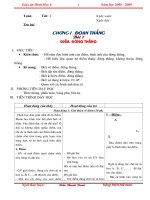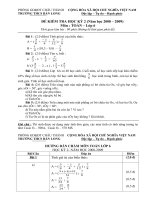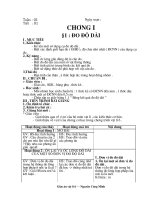- Trang chủ >>
- Đề thi >>
- THPT Quốc Gia
California science vocabulary card(1 6) (3)
Bạn đang xem bản rút gọn của tài liệu. Xem và tải ngay bản đầy đủ của tài liệu tại đây (7.42 MB, 166 trang )
mimicry
(mimºi krē)
Grade 3
© Macmillan/McGraw-Hill
Photograph by © Michael And Patricia Fogden/Minden Pictures
Photograph by © C Squared Studios/Getty Images, Inc.
© Macmillan/McGraw-Hill
Grade 3
Grade 3
(miksºchәr)
Vocabulary Routine
mixture
Define: When one thing imitates the traits of
another.
mimicry
Example: Some insects use mimicry to look like other
(mimºi krē)
insects and fool predators.
Ask: Why do some insects use mimicry to look
like a stick? (It can hide from predators or
attack its own prey.)
© Macmillan/McGraw-Hill
Grade 3
Photograph by © Michael And Patricia Fogden/Minden Pictures
Photograph by © C Squared Studios/Getty Images, Inc.
© Macmillan/McGraw-Hill
Grade 3
Published by Macmillan/McGraw-Hill, of McGraw-Hill Education, a division of The McGraw-Hill Companies, Inc.,
Two Penn Plaza, New York, New York 10121.
Ask: If you have a mixture of sand and gravel,
how can you separate the sand?
Copyright © by Macmillan/McGraw-Hill. All rights reserved. No part of this publication may be reproduced or distributed in
any form or by any means, or stored in a database or retrieval system, without the prior written consent of The McGraw-Hill
Companies, Inc., including, but not limited to, network storage or transmission, or broadcast for distance learning.
ingredients.
(miksºchәr)
Example: Soda is a mixture of sugar, water, and other
Printed in Mexico
mixture
Define: Different kinds of matter blended together.
1 2 3 4 5 6 7 8 9 078 09 08 07 06
Vocabulary Routine
ISBN 13: 978-0-02-286133-9
ISBN 10: 0-02-286133-5
VC3_CA_SC08_091-100.indd 98
VC3_CA_SC08_091-100.indd 97
8/21/06 3:12:48 PM
8/21/06 3:12:52 PM
Vocabulary Routine
Define: When one thing imitates the traits of
another.
Example: Some insects use mimicry to look like other
insects and fool predators.
Ask: Why do some insects use mimicry to look
like a stick? (It can hide from predators or
attack its own prey.)
Ask: If you have a mixture of sand and gravel,
how can you separate the sand?
Vocabulary Cards
Example: Soda is a mixture of sugar, water, and other
ingredients.
Vocabulary Cards help build word knowledge and
understanding of Science Glossary terms by:
• providing an opportunity for vocabulary preview,
Define: Different kinds of matter blended together.
review, and reinforcement
• fostering language development skills
• supporting the acquisition of academic language for
Vocabulary Routine
English learners
Vocabulary Cards can be placed in your classroom
Science Center.
VC3_CA_SC08_091-100.indd 98
8/21/06 3:12:52 PM
absorb
(әb sôrbº)
© Macmillan/McGraw-Hill
Photograph by (Green leaf): © David Fischer/Photodisc Red/Getty Images, Inc.
(Red flower): © Lisa Barber/Photonica/Getty Images, Inc.
Grade 3
Photograph by © Qt Luong/Terragalleria.Com
© Macmillan/McGraw-Hill
Grade 3
(aªdapªtāºshәn)
adaptation
Vocabulary Routine
Define: A special trait that helps a living thing survive in its environment.
Example: A fish’s gills are an example of adaptation.
Ask: How are a bear’s claws an adaptation that
helps it feed?
absorb?
Ask: Which colors of light does a green leaf
others.
Example: Some materials absorb more light than
Define: To take in.
Vocabulary Routine
air bladder
(âr
blaºdәr)
© Macmillan/McGraw-Hill
Grade 3
Photograph by © Marty Snyderman/Stephen Frink Collection/Alamy
Photograph by © Ralph A. Clevenger/CORBIS
© Macmillan/McGraw-Hill
Grade 3
(alºjē)
algae
Vocabulary Routine
Define: Tiny one-celled organisms that use
water, air, and sunlight to make food.
Example: Algae are plantlike living things often
found in shallow water.
Ask: How do you know that the green algae
growing on the surface of a pond is a
living thing?
it swim?
Ask: How does an air bladder inside a fish help
Example: Kelp has air bladders that help it float.
for holding gases.
Define: A balloonlike structure in plants and animals
Vocabulary Routine
arctic tundra
(ärkºtik
tәnºdrә)
© Macmillan/McGraw-Hill
Grade 3
Photograph by © B & C Alexander/NHPA
Photograph by © Blickwinkel/Alamy
© Macmillan/McGraw-Hill
Grade 3
(am fibºē әn)
amphibian
Vocabulary Routine
Define: An animal that spends part of its life in
water and part on land.
Example: Frogs and salamanders are amphibians.
Ask: What type of amphibian lives on the banks
of small streams?
Ask: How does the ground in the artic tundra
keep trees from growing there?
Example: Winters on the arctic tundra are long
and dark.
Define: A cold biome above the Arctic Circle.
Vocabulary Routine
asteroid
(asºtә roidª)
© Macmillan/McGraw-Hill
Photograph by © Kauko Helavuo/The Image Bank/Getty Images, Inc.
Grade 3
Photograph by © NASA/Science Photo Library
© Macmillan/McGraw-Hill
Grade 3
(asºtrә not)
astronaut
Vocabulary Routine
Define: A large piece of rock or metal in space.
Example: Many asteroids orbit the Sun.
Ask: What materials might be part of an asteroid
traveling through space?
Ask: Why do astronauts travel to the Moon?
Example: Astronauts traveled to the Moon to study
it up close.
Define: A person who travels into space.
Vocabulary Routine
astrophysicist
(asªtrō fiºzi sist)
© Macmillan/McGraw-Hill
Grade 3
Photograph by © Denis Finnin/American Museum Of Natural History
Photograph by © Colin Cuthbert/Photo Researchers, Inc.
© Macmillan/McGraw-Hill
Grade 3
(atº әm)
atom
Vocabulary Routine
Define: Someone who studies how objects in the
universe interact.
Example: An astrophysicist can explain how the
planets move around the Sun.
Ask: What types of questions about outer space
might an astrophysicist try to answer?
Ask: How can you observe the properties of
an atom if you cannot see it?
Example: Atoms are too small to see on your own.
Define: The smallest unit of an element that has
the properties of that element.
Vocabulary Routine
binary stars
(bīºnә rē
stârz)
© Macmillan/McGraw-Hill
Grade 3
Photograph by © STSci/NASA/Science Source/Photo Researchers, Inc.
Photograph by © Karen Minot
© Macmillan/McGraw-Hill
Grade 3
(akº sis)
axis
Vocabulary Routine
Define: A real or imaginary line through the center
of a spinning object.
Example: The geographic north and south poles are
the ends of Earth’s axis.
Ask: How long does it take for Earth to turn all
the way around on its axis?
Ask: If you looked at binary stars through a
telescope, what would you see?
Example: If one of the binary stars weakens, the
other one might absorb it.
Define: Two stars that act as a pair.
Vocabulary Routine
biomass
(bīºō mas)
© Macmillan/McGraw-Hill
Grade 3
Photograph by © Warren Gretz/Nrel/Us Department Of Energy/Science Photo Library
Photograph by © Annie Griffiths Belt/National Geographic/Getty Images, Inc.
© Macmillan/McGraw-Hill
Grade 3
(bīºōm)
biome
Vocabulary Routine
Define: An area of land or water that has certain
kinds of living and nonliving things.
Example: A desert biome is very different from an
ocean biome.
Ask: How can you tell where a grasslands biome
ends and a forest biome begins?
steam, or electricity?
Ask: How does burning biomass produce heat,
energy.
Example: Biomass can be used as fuel to produce
Define: Plant materials and animal waste.
Vocabulary Routine
brackish
environment
(brakºish en vīºrәn mәnt)
© Macmillan/McGraw-Hill
Grade 3
Photograph by © Age Fotostock/Superstock
Photograph by © G. P. Bowater/Alamy
© Macmillan/McGraw-Hill
Grade 3
(bog)
bog
Vocabulary Routine
Define: The living and nonliving things that exist in a
place with a mixture of fresh and salt water.
Example: Many marine animals lay their eggs in a
brackish environment.
Ask: What types of water are found in a brackish
environment?
Ask: Why do turtles live in bogs?
spongelike.
Example: The ground in bogs is usually wet and
and rich soil.
Define: A freshwater wetland filled with moss
Vocabulary Routine
camouflage
(kamºә fläzhª)
© Macmillan/McGraw-Hill
Grade 3
Photograph by © Ralph A. Clevenger/Corbis
Photograph by © Blickwinkel/Alamy
© Macmillan/McGraw-Hill
Grade 3
(bәºtrәs)
buttress
Vocabulary Routine
Define: Something that supports or strengthens.
Example: Some trees have special root structures
called buttresses that spread out from the
trunk and support the tree.
Ask: How do the thick roots on a tall tree act like
a buttress?
Ask: How does the pattern on a moth’s wing act
as camouflage?
Example: Camouflage might help an insect look like
a leaf.
Define: An adaptation that allows an animal to
blend into its surroundings.
Vocabulary Routine
carbon
(kärºbәn)
© Macmillan/McGraw-Hill
Grade 3
Photograph by (Diamond): © Lawrence Lawry/Photo Researchers, Inc., (Pencil tip):
© C Squared Studios/Getty Images, Inc., (Sugar cube): © Macmillan McGraw-Hill
Photograph by © Sandra Williams
© Macmillan/McGraw-Hill
Grade 3
(kaºnә pēª)
canopy
Vocabulary Routine
Define: The part of a forest just below the upper-
most branches of the tallest trees.
Example: Most rain-forest animals live in the canopy
because of the sunlight and food found
there.
Ask: Why do some insects live in the forest
canopy and never travel to the forest floor?
Ask: What are some things made out of carbon?
Example: All living matter on Earth contains carbon.
Define: One of the basic elements.
Vocabulary Routine
chemical
change
(kemºi kәl
© Macmillan/McGraw-Hill
Photograph by © TPH/allOver photography/Alamy
chānj)
Grade 3
Photograph by XXXXXXXXXXXXXXXXXX
© Macmillan/McGraw-Hill
(kemºi kәl
Grade 3
enºәr jē)
chemical
energy
Vocabulary Routine
Define: A change that causes matter with different
properties to form.
Example: When food burns, the chemical change
makes it taste different.
Ask: During a chemical change what kinds of
energy can be released?
Ask: How does the power of a battery come from
chemical energy?
Example: Your body uses chemical energy stored in
sugar and other foods.
Define: Energy that is stored in a substance.
Vocabulary Routine
comet
(komºit)
© Macmillan/McGraw-Hill
Grade 3
Photograph by © Astrofoto/Peter Arnold, Inc./Alamy
Photograph by © David L. Brown/Picturequest
© Macmillan/McGraw-Hill
Grade 3
(klīºmit)
climate









